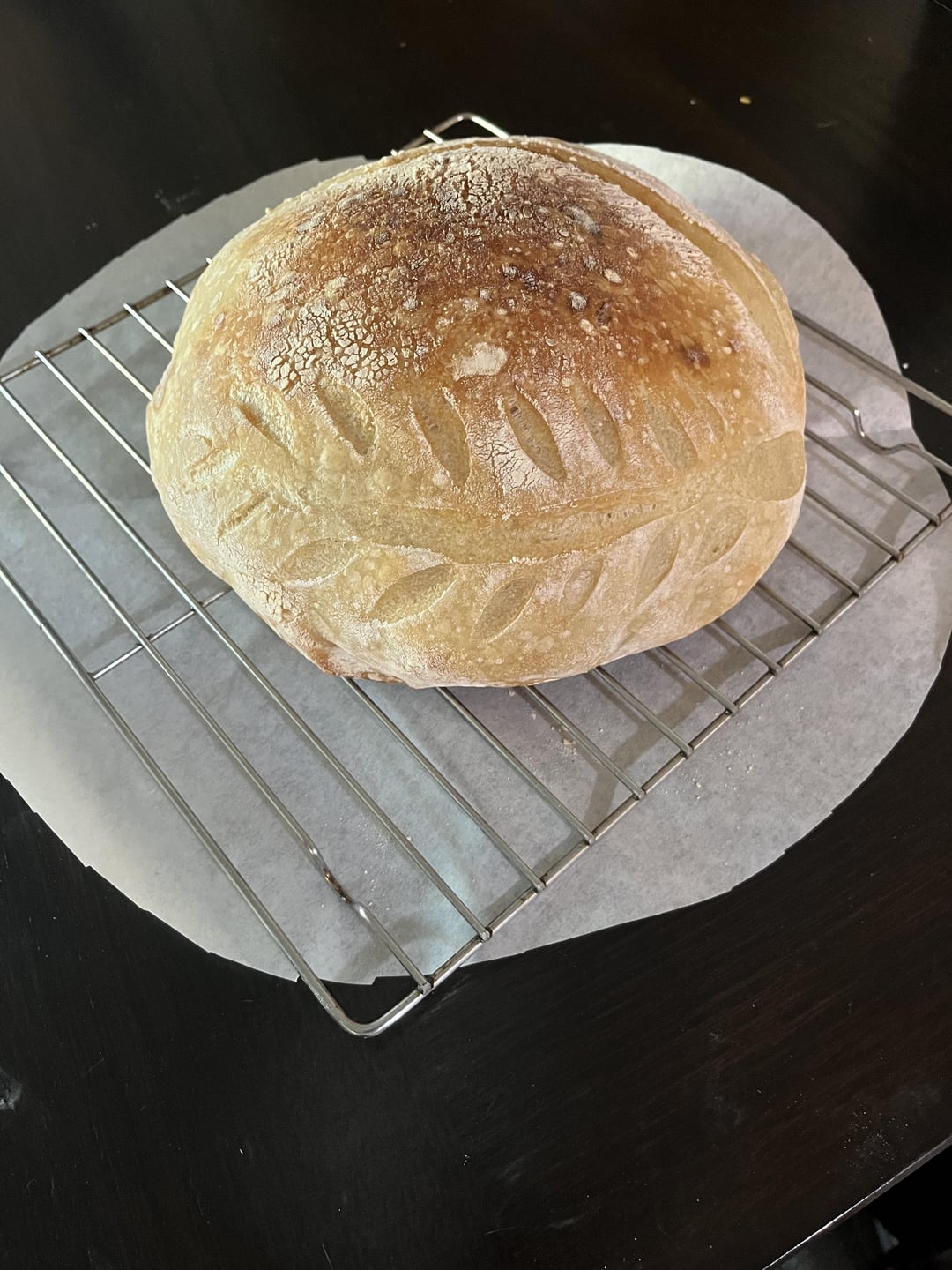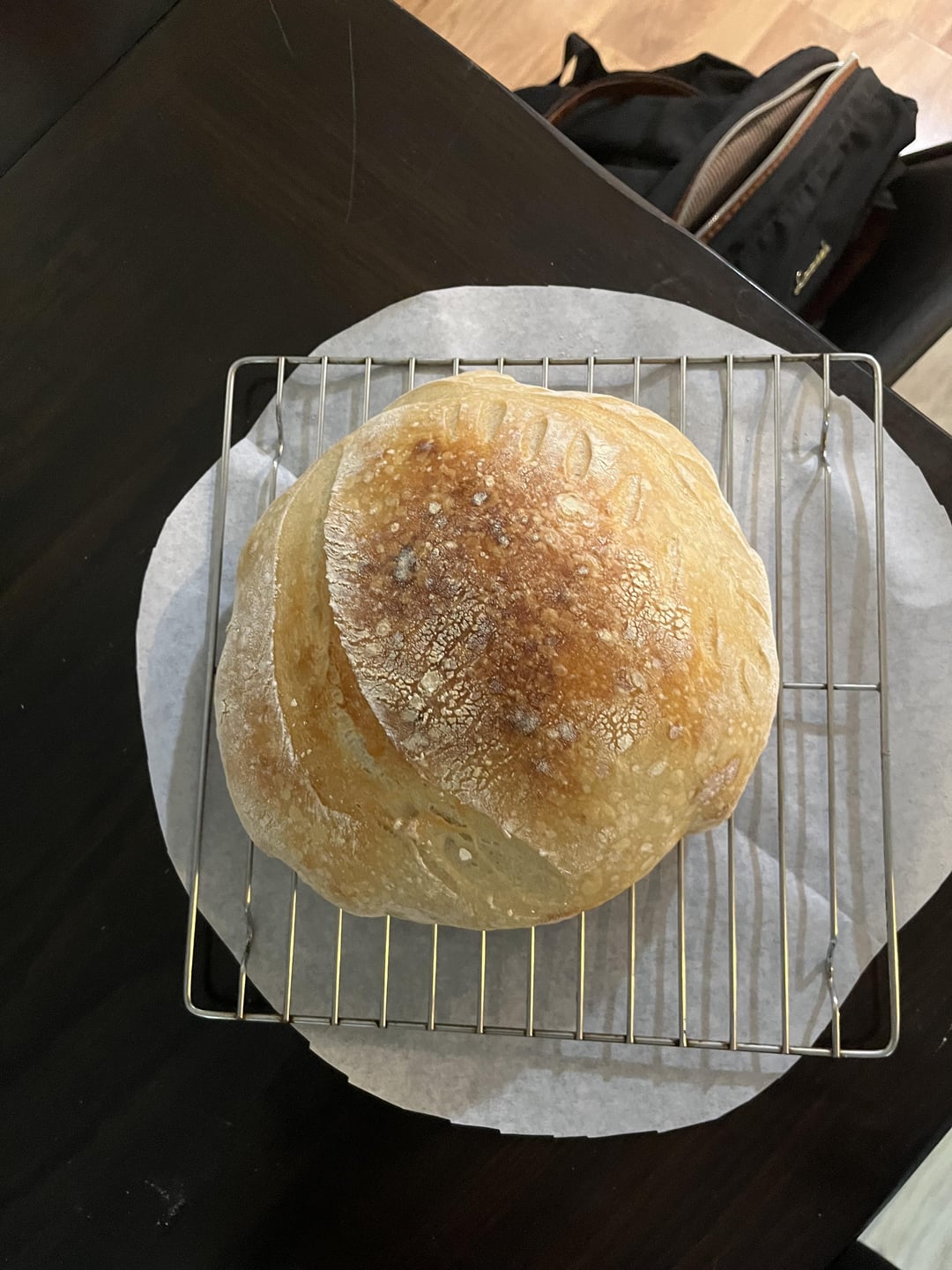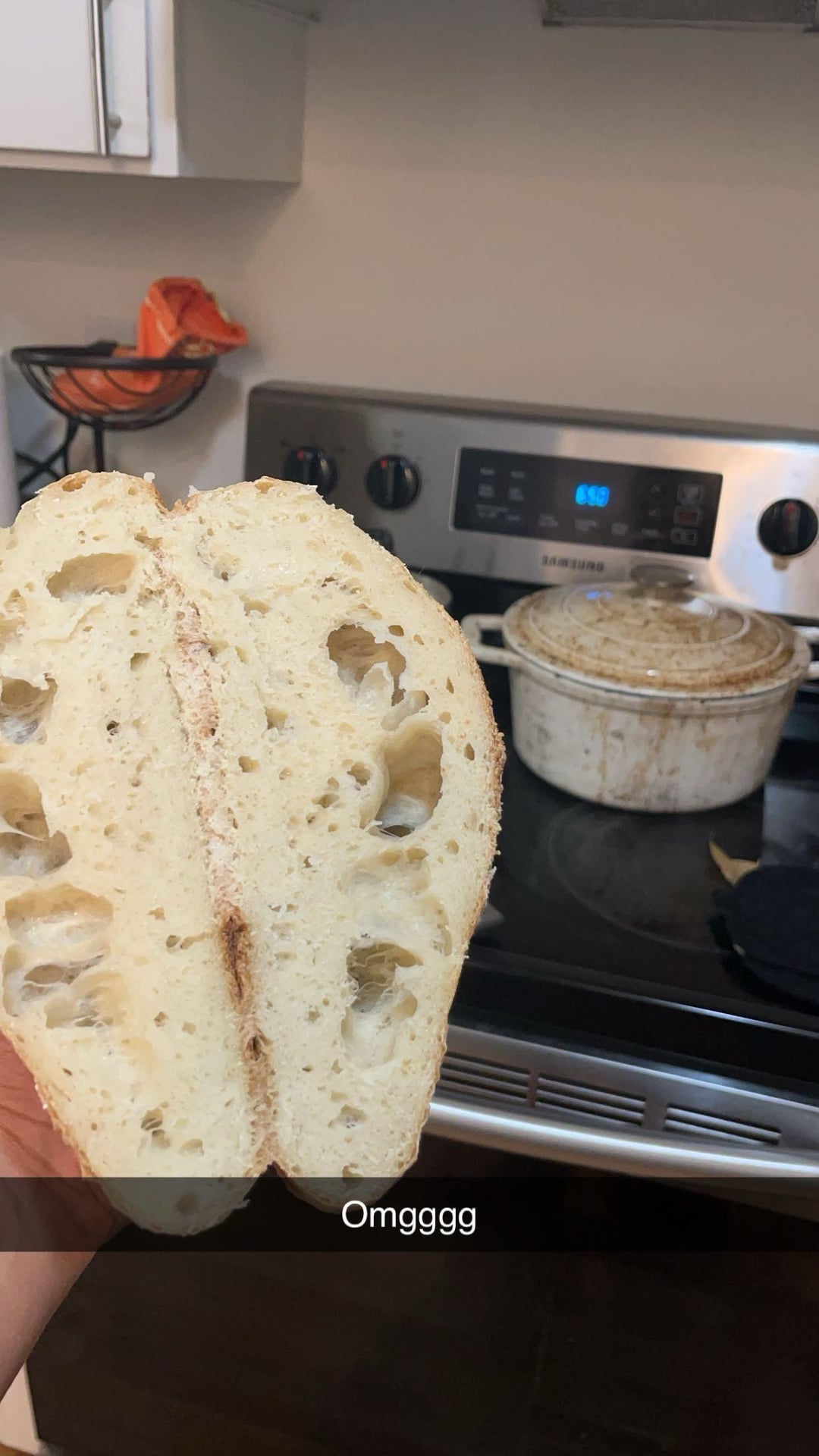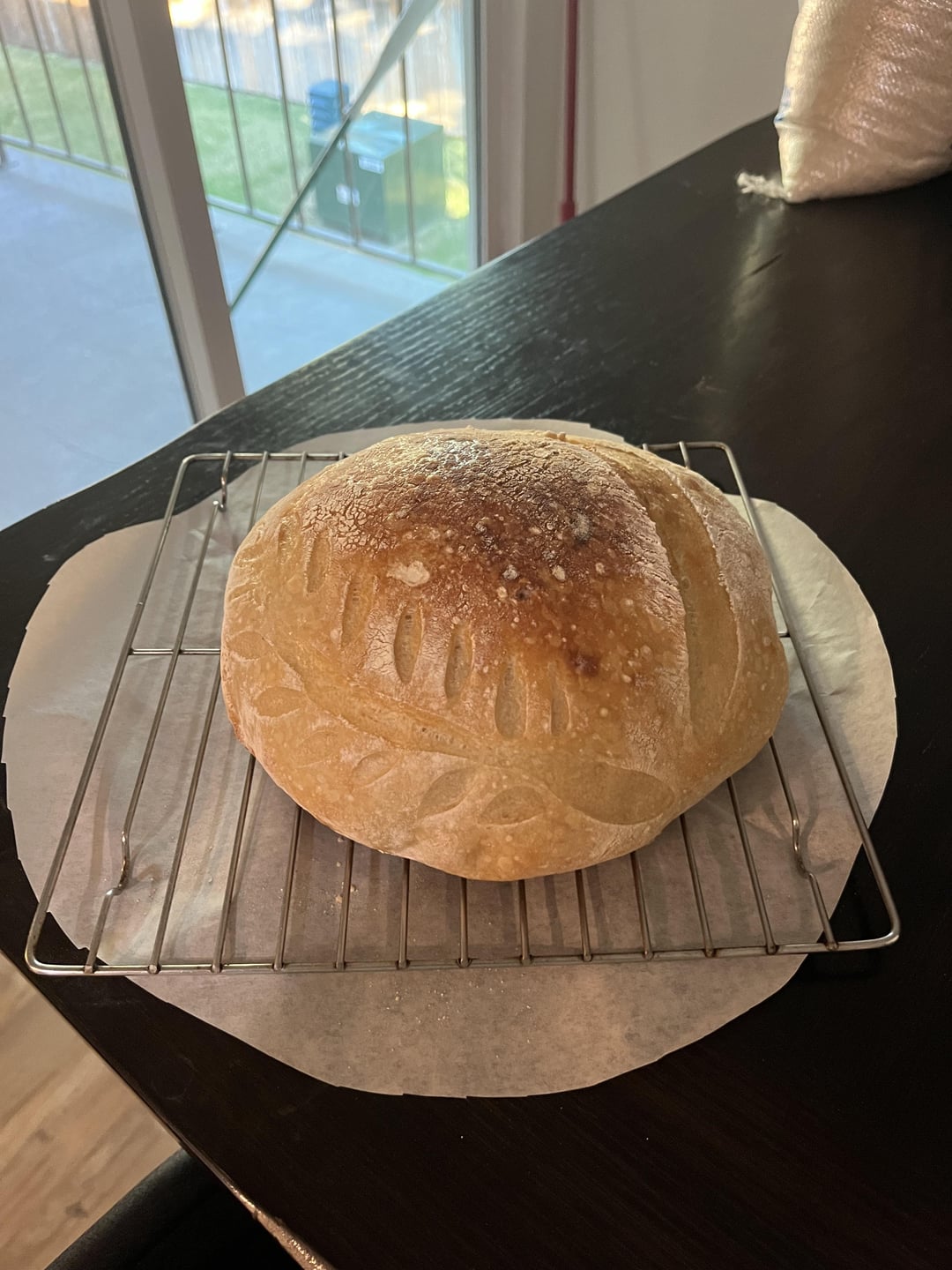



My first sourdough loaf and I’m pretty proud. I’m open to suggestions and advice as I think I’ll be making bread weekly. My starter is from a friend and I’ve been doing a bread flour amen water for feeding. I can put the recipe but it tasted very good. A little gummy with big holes. I know it isn’t supposed to be gummy but are holes good?
by Previous-Charge-2203

6 Comments
**Hello Previous-Charge-2203,**
#**This bot comment appears on all posts.**
***
**[Rule 5](https://www.reddit.com/r/Sourdough/wiki/sourdoughrules/) requires all sourdough photos to be accompanied by the ingredients used & process (the steps followed to make your bake). The details can be included in a picture, typed text or weblink.** **Not all posts require a photo alongside your query, but please add details in your post, so we can help.** **Posts may be removed at any time, but you will be notified.**
***
#**Being polite & respectful**
**are both extremely important in our community.** **[Read rule 1 in detail](https://www.reddit.com/r/Sourdough/wiki/sourdoughrules/).**
**Please be respectful, kind, patient & helpful to posters of all skill & knowledge levels and report offending comments/posters, or [drop us a modmail](https://www.reddit.com/message/compose?to=/r/Sourdough).**
***
**Thank you** 🙂
#**[Overproofed or underproofed?](https://www.reddit.com/r/Sourdough/wiki/reading_crumb/)**
***
#**[NEW Beginner starter FAQ guide](https://www.reddit.com/r/Sourdough/s/gnqFg7osBO)**
*I am a bot, and this action was performed automatically. Please [contact the moderators of this subreddit](/message/compose/?to=/r/Sourdough) if you have any questions or concerns.*
That loaf looks amazing! I can’t believe this is your first time, you’re a natural!
Congratulations on your first loaf! Enjoy it. Looks underfedmented as the bubbles are still rising up and you said it’s gummy. That’s an easy fix to just bulk ferment longer.
Levain: 20g active starter, 80g lukewarm water, 80g KA bread flour
Dough: 100g levain, 360g lukewarm water, 18g honey, 500g KA bread flour, 2 tsp salt
Day 1: Feed starter in am > 12 hours > make levain
> cover and place in warm area of kitchen > measure out 113g starter into fresh jar › cover and refrigerate starter
Day 2: Measure levain into bowl > add water and honey > stir together > sift in flour > stir until shaggy dough forms > rest 45 minutes > stir in salt > transfer dough to lightly oiled bowl > rest 45 minutes > 2 sets of stretch and folds 30 minutes apart > rest 30 minutes > 2 sets of coil folds 30 minutes apart > cover with cling wrap > proof 7-8 hours (68-73F depending on season) > pre-shape
> rest 30 minutes > shape and place in towel-lined bowl dusted with rice flour > refrigerate
Day 3: Do nothing but enjoy the smell every time you open your fridge (this day is optional – you can just skip to day 4
Day 4: Preheat oven with Dutch oven inside to
450F for 45 minutes > remove dough from fridge and place on parchment paper > score > place cookie sheet on rack beneath Dutch oven > place parchment paper with dough into preheated
Dutch oven > bake with lid on 25 minutes
> remove lid and continue baking 20-25 minutes or until crust is to desired color > remove from Dutch oven and cool on cooling rack 3 hours
4 days seems like a long time…. Looks like a decent first loaf though!
Hi. Welcome to the community. From the outside⭐⭐⭐⭐ from the inside ⭐⭐⭐😃 appears a little under cooked and definitely under fermented.
Phases:
• Mixing dough: The start of bulk fermentation.
This is basic method only put dry ingredients in bowl and combine. Add water and levain stir with stiff spoon or hand until all dry flour is combined. At this stage you have a chance to adjust your hydration to suit the flour but, over the next hour or two the flour will absorb more of the free fluids. So, aim for stickier than drier. I work the dough at this stage to a ensure that the dough is binding as a cohesive ‘ball’. Now the dough needs to rest.
Fermentation is a continuous process. Usually split in two. Bulk fermenttion is when multiple loaves are fermented together im one batch. Then proofing after the ‘ bulk ‘ has been reduced to individual loaves and shaped. Often times the proofing is done in refridgerated conditions to refine baking process. Especially with sourdough.
It is important to adjust the point at which the one finishes and the other starts. There needs tp be just enough ‘food’ to sustain the yeast through to baking. This is usually guaged by the % rise in vplume of the raw dough. The longer the intended proofing the lower the % age rise. There are several other ways to guage the curtailment point tho.
My preferred rise is about 75%. I measure the volume of the just mixed dough and then finish the ferment in a bowl marked to double that.
Forming gluten:
Several sets of folding and stretching and folding. Starts after a minimum rest of 1 hour autolyse(water absorbtion).
• simple bowl or counter stretch:
The dough will tend to stick to the surface. With wetted fingers tease up the far edge of the dough and lift up as far as it will without tearing, gently. Pull across to other side and lower down to seal on top. Twist 90° and repeat two or three times. When the dough resists, won’t lift, it is time to rest minimum 1/2hr to allow dough to relax. Repeat 3 to four times at 1/2 hour intervals
• Coil fold: bowl or counter. Tease wetted fingers in under edges of dough both sides, lift gently and allow self weight to draw down dough. Drop the near edge down ‘coiling’ the remaining bulk over to the other side. Repeat until the dough will not stretch under own weight. Time to rest dough . Three to four sets in all.
• Lift slap fold: on the counter , strectch dough to about 1″ thick. Reach over with wetted fingers and tease under corners. Lift up ajd across whole swinging the dough away so the dropping free edge slaps down then fold over the held corners and tap down. Repeat 3 to 4 times. Until no more stretch. Repeat sets at 1/2 hour intervals.
These folds are mix and match 3 to 4 sets combined total.
• Letter fold: like laminating; part of shaping process. Stretch dough out to roughly 1/2 ” thick rectangle. Lift far edge over to third point then fold other edge over. Tightly roll dough and pul tuck corners under bulk of dough to tension the boule. Lift and place in prepared banetton ready to proof after a rest of a minimum of 1/2 hour.
Baking:
25 mins at 450 and 20 mins at 410 shield wirh feel to prevent over caramelisation
Happt baking